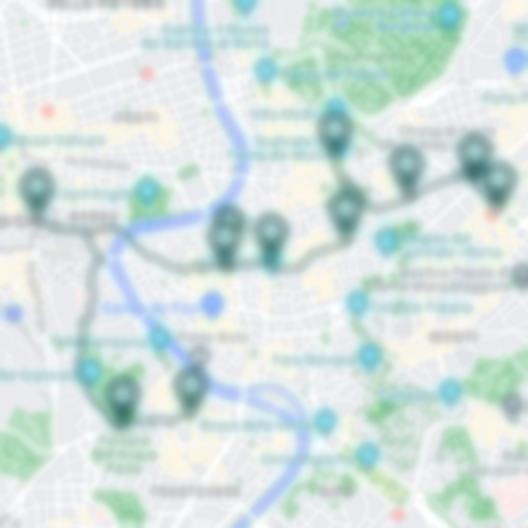A visit to Rome is incomplete without a pilgrimage to the city’s majestic churches. Each of these incredible places of worship contain a wealth of history and artistry that has been crafted by some of the most renowned masters in the world. From Michelangelo to Caravaggio, these churches are filled with works of art that have stood the test of time. For centuries, pilgrims have made the arduous journey to Rome to visit these seven sites that are known as pilgrimage churches.
Today, tourists from all over the world flock to these churches to marvel at their stunning architecture and the works of art contained within. Whether it is a devout pilgrimage or simply an exploration of the city, a visit to the churches of Trastevere Rome is an absolute must. From breathtaking frescoes to exquisite mosaics, these churches are truly a sight to behold.
Basilica of Our Lady in Trastevere (Basilica di Santa Maria in Trastevere)
📍 Piazza di Santa Maria in Trastevere, 00153 Roma RM, Italy
⏰ Every day: 7.30 – 20.30
Santa Maria in Trastevere is one of the oldest churches in Rome, with construction beginning during the 3rd century. The current facade, which includes intricate mosaic detailing, was built during the 12th century. The campanile, or bell tower, is of Romanesque design and the portico houses several ancient Christian sarcophagi. Inside, the beautiful marble inlay and gilded, coffered wood ceiling will take your breath away. The intricate mosaics in the apse, which date back to the medieval period, depict Christ, the Virgin Mary and various saints. The frieze of lambs below the main artwork, was crafted by Pietro Cavallini in the late 13th century. The 15th century tabernacle, created by Mino del Reame, is located at the right end of the nave. Santa Maria in Trastevere is a stunning example of the rich heritage of Rome.
Basilica of Santa Cecilia in Trastevere (Basilica di Santa Cecilia in Trastevere)
📍 Piazza di Santa Cecilia, 22, 00153 Roma RM, Italy
⏰ Every day: 9.30 – 13.00 and 16.00 – 19.15
The Basilica of St. Cecilia is a sacred site located on the family home of the noble Cecilia, a martyr who was killed in 230AD. According to legend, Pope Urban I witnessed her torture and buried her body on the site, transforming it into a church. Since the 5th century it has been known as Titulus Ceaciliae and in the 6th century it was remodeled into a primitive basilica.
The basilica has undergone numerous renovations including the addition of a cloister, atrium and bell tower and the transposition of the body of Saint Cecilia in the 9th century by Pope Pasquale I. In 1599, during the renovation works, Cardinal Sfondrati had the tomb of Santa Cecilia opened, revealing her miraculously intact body.
The interior of the basilica is divided into three naves. The ciborium in black and white marble is a Gothic work by Arnolfo di Cambio (1293) and the counterfacade houses the Last Judgment by Pietro Cavallini, painted at the end of the 13th century. Under the altar, the famous statue of Santa Cecilia by Stefano Maderno (1600) is displayed.
The church of San Pietro in Montorio (Chiesa di San Pietro in Montorio)
📍 Piazza di S. Pietro in Montorio, 2, 00153 Roma RM, Italy
⏰ Every day: 09.00 – 12.00 and 15.00 – 16.00
The Church of San Pietro in Montorio is a small Roman Catholic church located on the Janiculum Hill in Rome. Founded in the 9th century and rebuilt in the late 15th century, the church was funded by the King of Spain and was consecrated by Alexander VI Borgia in 1500. The church is especially known for its Renaissance façade, built in 1605 and attributed to the school of Andrea Bregno or Meo del Caprina, as well as its single nave, which contains five side chapels, designed by a variety of artists. Inside the church are notable pieces of art, such as Sebastiano del Piombo’s painting, The Scourging of Christ, and Raphael’s Transfiguration altarpiece, which was expropriated by the French in 1797 and has since been repatriated to the Vatican Museums. In addition, the mortal remains of Beatrice Cenci, who was executed in 1599, are said to be buried below the altar. The first cloister of the friary also contains the Tempietto del Bramante, a representative work of Italian Renaissance architecture. For centuries, the church has had special significance for Ireland, due to the burials of Hugh O’Neill and Rory O’Donnel, the two earls who fled to Rome after the Tudor conquest of Ireland in 1607.
The church of San Francesco a Ripa (Chiesa di San Francesco a Ripa)
📍 Piazza di S. Francesco d’Assisi, 88, 00153 Roma RM, Italy
⏰ Every day: 07.30 – 12.30 and 16.30 – 19.30
San Francesco a Ripa, a charming church in Rome’s lively Trastevere quarter, is dedicated to St. Francis of Assisi who visited the city in 1219. It stands close to the banks of the Tiber River, known as the “ripa”, and was constructed by a Franciscan follower of the influential Anguillara family. The church was completely rebuilt in 1680, with the room where St. Francis stayed still maintained, including his stone pillow and crucifix.
However, the main attraction of the church is the exquisite sculpture by Gian Lorenzo Bernini – the Ecstasy of Beata Ludovica – which is an exceptionally sensual rendering in stone. This remarkable piece of art has made San Francesco a Ripa a must-see for tourists visiting the Eternal City.
Basilica of Saint Chrysogonus (Basilica di San Crisogono)
📍 Piazza Sidney Sonnino, 00153 Roma RM, Italy
⏰ Every day: 07.00 – 12.00 and 15:30 – 19.00
The Basilica of San Crisogono in Rome’s historical district of Trastevere is often overlooked by visitors. However, the 17th-century structure hides an extraordinary archaeological excavation beneath its floors, which visitors can explore quite easily and often completely alone. Descend the stairs from the sacristy to the excavations and find traces of a 4th-century church, one of the oldest in Rome. The single-nave church was discovered in 1907 and features a semicircular apse, the secretarium and a baptistery with a baptismal font. Also visible are 8th-century frescoes of three saints, including Chrysogonus, and a cycle of 10th-11th century frescoes depicting the lives of Saint Benedict and Pope Sylvester. In the narthex, visitors can see several ancient sarcophagi, including a 2nd-century one with sea deities and another decorated with muses. Various remains of earlier Roman housing have also been discovered. The Basilica of San Crisogono is well worth a visit for its hidden archaeological treasures.
Church of St Onuphrius at the Janiculum (Chiesa di Sant’Onofrio al Gianicolo)
📍 Piazza di Sant’Onofrio, 2, 00165 Roma RM, Italy
⏰ Sunday only: 9.00 – 12.00
The Church at the top of Salita di Sant’Onofrio is a Gothic and Renaissance building constructed in 1439, dedicated to St Onuphrius, a 4th century Egyptian hermit. It is preceded by an entrance garden closed on two sides by a small Renaissance portico frescoed at the beginning of the 1600s and a Chapel of Our Lady of the Rosary decorated with the Sibyls. At the center of the churchyard stands a fountain, originally part of the fountain at the destroyed Piazza Giudia. Inside the church, frescoes by great masters such as Agostino Carracci, Antoniazzo Romano and Pinturicchio and Baldassarre Peruzzi adorn the walls. Attached to it is the monastery which includes a 15th-century cloister with a series of lunette frescoes by the Cavalier d’Arpino. It is also the place where the epic poet Torquato Tasso spent his last days before his death in 1595. A museum dedicated to him displays his manuscripts and death mask. This complex is a true testament to centuries of history and art.
Church of Sant’Agata in Trastevere (Chiesa di Sant’Agata in Trastevere)
📍 Largo S. Giovanni de Matha, 00153 Roma RM, Italy
⏰ Every day: 9.00 – 12.00 and 16.00 – 19.00
Located in Rome’s Rione Trastevere, the Church of San Crisogono is dedicated to the noble martyr from Catania of the mid-third century. It is believed to have been built in the 8th century AD, although the first known historical information dates it to the 12th century. The 18th-century façade was designed by Giacomo Onorato Recalcati, featuring two orders with late Baroque forms and Borrominian elements. The interior has a single nave with three chapels on each side and a marble floor. The main altar is dominated by a majestic altarpiece by Biagio Puccini, depicting the Martyrdom of Saint Agatha.
In addition to Puccini’s work, the church contains several other art pieces, such as the Virgin appears to St. Gregory II by D. Monastello and the 18th-century altarpiece in the first chapel on the right, depicting San Michele Arcangelo. To the left of the main altar is the wooden statue of the Madonna del Carmine, patroness of the district, celebrated with a precession every 16th of July.
Our walking map of Trastevere is perfect for anyone looking for an adventure. Whether you’re a first-time visitor or a seasoned traveler, you’ll find something new and exciting in this charming neighborhood. So grab your map and get ready to experience the best of Rome!


